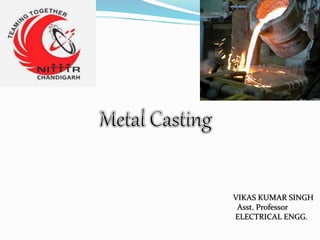
METAL CASTING vikassingh
- 1. VIKAS KUMAR SINGH Asst. Professor ELECTRICAL ENGG.
- 2. Content Casting Casting Term Basic Features of Casting Sand Casting Terminology Application of Casting Function of Pattern Selection of Pattern Material and its type Types of Pattern Allowances Moulding Material & Types of Moulding Sand
- 3. ” Foundry or casting is the process of producing metal/alloy component parts of desired shapes by pouring the molten metal/alloy into a prepared mould (of that shape) and then allowing the metal/alloy to cool and solidify. The solidified piece of metal/alloy is known as a CASTING”.
- 4. Casting Terms: 1. Flask: A metal or wood frame, without fixed top or bottom, in which the mold is formed. drag - lower molding flask, cope - upper molding flask, cheek - intermediate molding flask used in three piece molding.
- 5. Casting Terms: 2. Pattern: It is the replica of the final object to be made. The mold cavity is made with the help of pattern. 3. Parting line: This is the dividing line between the two molding flasks that makes up the mold. Pattern
- 6. 4. Pouring basin: A small funnel shaped cavity at the top of the mold into which the molten metal is poured. 5. Sprue: The passage through which the molten metal, from the pouring basin, reaches the mold cavity. In many cases it controls the flow of metal into the mold.
- 7. 6. Runner: The channel through which the molten metal is carried from the sprue to the gate. 7. Riser: A column of molten metal placed in the mold to feed the castings as it shrinks and solidifies. Also known as feed head. 8. Gate: A channel through which the molten metal enters the mold cavity.
- 8. 9. Core: A separate part of the mold, made of sand and generally baked, which is used to create openings and various shaped cavities in the castings. 10.Chaplets: Chaplets are used to support the cores inside the mold cavity to take care of its own weight and overcome the metallostatic force. 11. Vent: Small opening in the mold to facilitate escape of air and gases.
- 9. Basic Features: Pattern and Mould A pattern is made of wood or metal, is a replica of the final product and is used for preparing mould cavity. Mould material should posses refractory characteristics and with stand the pouring temperature.
- 10. Schematic diagram of casting mould:
- 12. 1. Make the pattern out of Wood , Metal or Plastic. 2. Prepare the necessary sand mixtures for mould and core making. 3. Prepare the Mould and necessary Cores. 4. Melt the metal/alloy to be cast. 5. Pour the molten metal/alloy into mould and remove the casting from the mould after the metal solidifies. 6. Clean and finish the casting. 7. Test and inspect the casting. 8. Remove the defects, if any. 9. Relieve the casting stresses by Heat Treatment. 10. Again inspect the casting. 11. The casting is ready for shipping.
- 13. Applications of Casting: Transportation vehicles Turbine vanes Power generators Railway crossings Agricultural parts Aircraft jet engine parts Sanitary fittings Communication, Construction and Atomic Energy applications, etc..
- 14. Functions of Patterns: A Pattern prepares a mould cavity for the purpose of making a casting. A Pattern may contain projections known as core prints if the casting requires a core and need to be made hollow. Patterns properly made and having finished and smooth surfaces reduce casting defects. Properly constructed patterns minimize overall cost of the casting.
- 15. Pattern having core prints
- 16. Selection of Pattern Materials: The following factors assist in selecting proper pattern material: No. of castings to be produced. Dimensional accuracy & surface finish. Shape, complexity and size of casting. Casting design parameters. Type of molding materials. The chance of repeat orders. Nature of molding process.
- 17. The pattern material should be: 1. Easily worked, shaped and joined. 2. Light in weight. 3. Strong, hard and durable. 4. Resistant to wear and abrasion . 5. Resistant to corrosion, and to chemical reactions. 6. Dimensionally stable and unaffected by variations in temperature and humidity. 7. Available at low cost.
- 18. Materials for making patterns: WOOD METAL PLASTIC PLASTER WAX
- 19. Types of Patterns: Single piece pattern. Split pattern Loose piece pattern Match plate pattern Sweep pattern Gated pattern Skeleton pattern Follow board pattern Cope and Drag pattern
- 20. (a)Split pattern (b) Follow-board (c) Match Plate (d) Loose-piece (e) Sweep (f) Skeleton pattern
- 21. Types of Pattern Allowances: The various pattern allowances are: 1. Shrinkage or contraction allowance. 2. Machining or finish allowance. 3. Draft of tapper allowances. 4. Distortion or chamber allowance. 5. Shake or rapping allowance.
- 22. Moulding Materials Major part of Moulding material in sand casting are 1. 70-85% silica sand (SiO2) 2. 10-12% bonding material e.g., clay cereal etc. 3. 3-6% water Properties of molding sand are: (a) Refractoriness (b) Cohesiveness (c) Strength/Adhesiveness (d) Permeability (e) Collapsibility (f) Flowability (g) Chemical Inactiveness
- 23. Types of Moulding Sand 1. Green Sand 2. Dry Sand 3. Facing Sand 4. Loam Sand 5. Backing Sand 6. Parting Sand 7. Core Sand
- 24. Mixing moulding sand with binders & adhesives
- 26. Melting furnace
- 28. Knock out
- 29. Heat treatment
- 30. Machining
- 31. final products of casting
- 32. THANK YOU